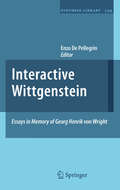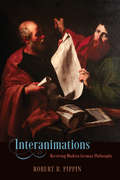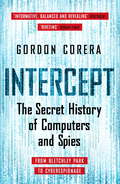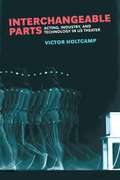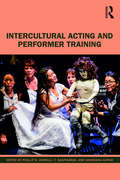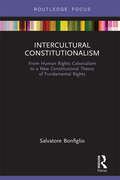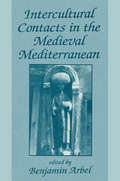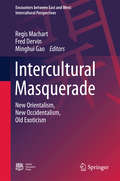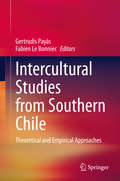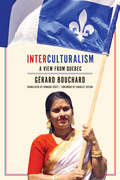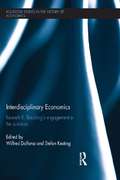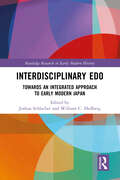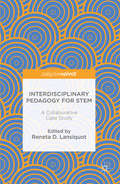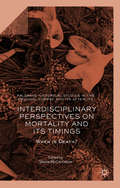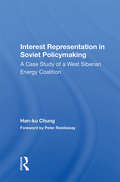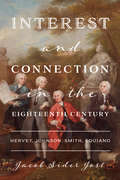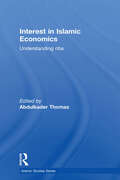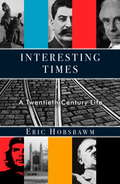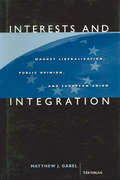- Table View
- List View
Interactive Wittgenstein
by Enzo De PellegrinThe philosophical thought of Ludwig Wittgenstein continues to have a profound influence that transcends barriers between philosophical disciplines and reaches beyond philosophy itself. Less than one hundred years after their publication, his early masterpiece 'Tractatus Logico-Philosophicus' and the posthumously published 'Philosophical Investigations' have emerged as two classic philosophical texts, each of which has elicited widely divergent readings and spawned contesting schools of interpretation. This collection of original essays by leading experts offers deep insights into the forces that shaped and influenced Wittgenstein's thought on a broad variety of topics. It also contains the text - in both the original German and an English translation by Juliet Floyd and Burton Dreben - of letters and cards sent to Wittgenstein by the philosopher and logician Gottlob Frege, which shed light on their interaction during the crucial period when Wittgenstein completed work on the 'Tractatus'. This important record of a philosophical friendship is complemented by a scholarly apparatus and an introduction. Other essays featured in this volume document and discuss Wittgenstein's thinking on music and religion as well as issues that take center stage in the 'Investigations' such as Wittgenstein's account of rule-following. The volume provides an invaluable research tool not only for students of the history of philosophy and for scholars of both Wittgenstein and Frege but also for anyone interested in the intellectual history of the first half of the twentieth century.
Interanimations: Receiving Modern German Philosophy
by Robert B. PippinIn this latest book, renowned philosopher and scholar Robert B. Pippin offers the thought-provoking argument that the study of historical figures is not only an interpretation and explication of their views, but can be understood as a form of philosophy itself. In doing so, he reconceives philosophical scholarship as a kind of network of philosophical interanimations, one in which major positions in the history of philosophy, when they are themselves properly understood within their own historical context, form philosophy’s lingua franca. Examining a number of philosophers to explore the nature of this interanimation, he presents an illuminating assortment of especially thoughtful examples of historical commentary that powerfully enact philosophy. After opening up his territory with an initial discussion of contemporary revisionist readings of Kant’s moral theory, Pippin sets his sights on his main objects of interest: Hegel and Nietzsche. Through them, however, he offers what few others could: an astonishing synthesis of an immense and diverse set of thinkers and traditions. Deploying an almost dialogical, conversational approach, he pursues patterns of thought that both shape and, importantly, connect the major traditions: neo-Aristotelian, analytic, continental, and postmodern, bringing the likes of Heidegger, Honneth, MacIntyre, McDowell, Brandom, Strauss, Williams, and Žižek—not to mention Hegel and Nietzsche— into the same philosophical conversation. By means of these case studies, Pippin mounts an impressive argument about a relatively under discussed issue in professional philosophy—the bearing of work in the history of philosophy on philosophy itself—and thereby he argues for the controversial thesis that no strict separation between the domains is defensible.
Intercept: The Secret History of Computers and Spies
by Gordon CoreraThe computer was born to spy, and now computers are transforming espionage. But who are the spies and who is being spied on in today's interconnected world? This is the exhilarating secret history of the melding of technology and espionage. Gordon Corera's compelling narrative, rich with historical details and characters, takes us from the Second World War to the internet age, revealing the astonishing extent of cyberespionage carried out today. Drawing on unique access to intelligence agencies, heads of state, hackers and spies of all stripes, INTERCEPT is a ground-breaking exploration of the new space in which the worlds of espionage, geopolitics, diplomacy, international business, science and technology collide. Together, computers and spies are shaping the future. What was once the preserve of a few intelligence agencies now matters for us all.
Intercept: The Secret History of Computers and Spies
by Gordon CoreraThe computer was born to spy, and now computers are transforming espionage. But who are the spies and who is being spied on in today's interconnected world? This is the exhilarating secret history of the melding of technology and espionage. Gordon Corera's compelling narrative, rich with historical details and characters, takes us from the Second World War to the internet age, revealing the astonishing extent of cyberespionage carried out today. Drawing on unique access to intelligence agencies, heads of state, hackers and spies of all stripes, INTERCEPT is a ground-breaking exploration of the new space in which the worlds of espionage, geopolitics, diplomacy, international business, science and technology collide. Together, computers and spies are shaping the future. What was once the preserve of a few intelligence agencies now matters for us all.
Interchangeable Parts: Acting, Industry, and Technology in US Theater (Theater: Theory/Text/Performance)
by Victor HoltcampWhile Hollywood has long been called “The Dream Factory,” and theatrical entertainment more broadly has been called “The Industry,” the significance of these names has rarely been explored. There are in fact striking overlaps between industrial rhetoric and practice and the development of theatrical and cinematic techniques for rehearsal and performance. Interchangeable Parts examines the history of acting pedagogy and performance practice in the United States, and their debts to industrial organization and philosophy. Ranging from the late nineteenth century through the end of the twentieth, the book recontextualizes the history of theatrical technique in light of the embrace of industrialization in US culture and society. Victor Holtcamp explores the invocations of scientific and industrial rhetoric and philosophy in the founding of the first schools of acting, and echoes of that rhetoric in playwriting, production, and the cinema, as Hollywood in particular embraced this industrially infected model of acting. In their divergent approaches to performance, the major US acting teachers (Lee Strasberg, Stella Adler, and Sanford Meisner) demonstrated strong rhetorical affinities for the language of industry, illustrating the pervasive presence of these industrial roots. The book narrates the story of how actors learned to learn to act, and what that process, for both stage and screen, owed to the interchangeable parts and mass production revolutions.
Intercultural Acting and Performer Training
by Zarrilli Phillip T Sasitharan Anuradha KapurIntercultural Acting and Performer Training is the first collection of essays from a diverse, international group of authors and practitioners focusing on intercultural acting and voice practices worldwide. This unique book invites performers and teachers of acting and performance to explore, describe, and interrogate the complexities of intercultural acting and actor/performer training taking place in our twenty-first century, globalized world. As global contexts become multi-, inter- and intra-cultural, assumptions about what acting "is" and what actor/performer training should be continue to be shaped by conventional modes, models, techniques and structures. This book examines how our understanding of interculturalism changes when we shift our focus from the obvious and highly visible aspects of production to the micro-level of training grounds, studios, and rehearsal rooms, where new forms of hybrid performance are emerging. Ideal for students, scholars and practitioners, Intercultural Acting and Performer Training offers a series of accessible and highly readable essays which reflect on acting and training processes through the lens offered by "new" forms of intercultural thought and practice.
Intercultural Constitutionalism: From Human Rights Colonialism to a New Constitutional Theory of Fundamental Rights
by Salvatore BonfiglioThis book argues that the effective protection of fundamental rights in a contemporary, multicultural society requires not only tolerance and respect for others, but also an ethics of reciprocity and a pursuit of dialogue between different cultures of human rights. Nowadays, all cultures tend to claim an equitable arrangement that can be articulated in the terms of fundamental rights and in the multicultural organization of the State. Starting from the premise that every culture is and always was intercultural, this book elaborates a new, and more fundamentally, pluralist view of the relationship between rights and cultural identity. No culture is pure; from the perspective of an irreducible cultural contamination, this book argues, it is possible to formulate constitutional idea of diversity that is properly intercultural. This concept of intercultural constitutionalism is not, then, based on abstract principles, but nor is it bound to any particular cultural norm. Rather, intercultural constitutionalism allows the interpretation of rights, rules and legal principles, which are established in different contexts.
Intercultural Contacts in the Medieval Mediterranean: Studies in Honour of David Jacoby
by Benjamin ArbelThese essays by medievalists touch upon many aspects of intercultural links in the medieval Mediterranean, covering not only strictly cultural and religious contacts, but also political, military, ethnic, social institutional, scientific and technological relationships.
Intercultural Education, Folklore, and the Pedagogical Thought of Rachel Davis DuBois
by Jan RosenbergThis book provides a history of the Quaker educator and intercultural education pioneer Rachel Davis DuBois (1892-1993) that explores the period in which DuBois lived and the key works she created. The opening section establishes the disciplinary contexts of her work, education, and folklore, and the subsequent sections present DuBois' pedagogical methods as they were developed and exemplified by her programs. Throughout the narrative, Rosenberg includes reflections on her own experience as a practitioner of the intercultural and folklife education DuBois championed.
Intercultural Masquerade
by Fred Dervin Regis Machart Minghui GaoThis volume revisits the notions of Orientalism, Occidentalism and, to a certain extent, Reverse Orientalism/Occidentalism in the 21st century, adopting post-modern, constructionist and potentially non-essentialising approaches. The representations of the 'cultural Other' in education, literature and the arts are examined by scholars working in Australia, France, Hong Kong, Japan, Malaysia, Singapore and the USA. Vinyl compilations, TV series, novels, institutional discourses and surveys, amongst others, are examined so as to better understand how people construct their identity in relation to an imagined and idealised Other. This book will appeal to all researchers and students interested in cultural identity and stereotypes of the 'East' and the 'West', in particular in the fields of academic mobility, cultural studies, intercultural education, postcolonial literature and media studies.
Intercultural Studies from Southern Chile: Theoretical and Empirical Approaches
by Gertrudis Payàs Fabien Le BonniecThis book presents a multidisciplinary overview of a little known interethnic conflict in the southernmost part of the Americas: the tensions between the Mapuche indigenous people and the settlers of European descent in the Araucania region, in southern Chile. Politically autonomous during the colonial period, the Mapuche had their land confiscated, their population decimated and the survivors displaced and relocated as marginalized and poor peasants by Chilean white settlers at the end of the nineteenth century, when Araucania was transformed in a multi-ethnic region marked by numerous tensions between the marginalized indigenous population and the dominant Chileans of European descent.This contributed volume presents a collection of papers which delve into some of the intercultural dilemmas posed by these complex interethnic relations. These papers were originally published in Spanish and French and provide a sample of the research activities of the Núcleo de Estudios Interétnicos e Interculturales (NEII) at the Universidad Católica de Temuco, in the capital of Araucania. The NEII research center brings together scholars from different fields: sociocultural anthropology, sociolinguistics, ethno-literature, intercultural education, intercultural philosophy, ethno-history and translation studies to produce innovative research in intercultural and interethnic relations. The chapters in this volume present a sample of this work, focusing on three main topics: The ambivalence between the inclusion and exclusion of indigenous peoples in processes of nation-building.The challenges posed by the incorporation of intercultural practices in the spheres of language, education and justice.The limitations of a functional notion of interculturality based on eurocentric thought and neoliberal economic rationality. Intercultural Studies from Southern Chile: Theoretical and Empirical Approaches will be of interest to anthropologists, linguists, historians, philosophers, educators and a range of other social scientists interested in intercultural and interethnic studies.
Interculturalism
by Charles Taylor Howard Scott Gerard BouchardAccommodating ethnic diversity is a major challenge for all democratic nations and a topic that has attracted a great deal of attention in the last few decades. Within Quebec, a new approach has emerged that seeks a balance between the needs of minorities and those of the majority.In Interculturalism, sociologist and historian Gérard Bouchard presents his vision of interculturalism as a model for the management of diversity. A pluralist approach which recognizes the existence of a cultural majority whose rights must also be acknowledged, interculturalism constitutes an important alternative to multiculturalism both in Canada and internationally. Written by one of Quebec's leading public intellectuals and the co-chair of the Bouchard-Taylor Commission on reasonable accommodation, Interculturalism is the first clear and comprehensive statement in English of an approach being discussed around the world.A translation of Bouchard's award-winning French-language work, L'Interculturalisme: Un point de vue québécois, this book features a new foreword by philosopher Charles Taylor and an afterword by the author written specifically for the English-language edition.
Interdisciplinary Economics: Kenneth E. Boulding’s Engagement in the Sciences (Routledge Studies in the History of Economics #155)
by Wilfred Dolfsma Stefan KestingKenneth Boulding was a prolific writer across so many different fields that not only is he often much referred to and cited, he is considered a core member of many of these fields. Boulding is the quintessential interdisciplinary scholar. He died in 1993, but he has left a legacy in economics, conflict studies, systems theory, ecology, biology, communication studies, and ethics. As an economist proper he has tested and expanded the boundaries of that field without unduly "invading" and undermining the expertise and established knowledge of the other social sciences. This proposed volume will allow scholars who have worked or are starting to work in areas that Boulding has initiated, established and made a continued contribution to, to understand the links between these fields and other related ones. The volume will establish a source of inspiration for some time to come.
Interdisciplinary Edo: Toward an Integrated Approach to Early Modern Japan (Routledge Research in Early Modern History)
by William C. Hedberg Joshua SchlachetInterdisciplinary Edo brings together scholars from across the methodological spectrum to explore new approaches to innovative humanistic research on early modern Japan (1603–1868). It makes an intervention in the field by thinking across conventional disciplinary boundaries toward a holistic and cohesive approach to Japan’s early modern period. By taking historical, religious, literary, and art historical analyses into account, the contributors hope to begin a new, transdisciplinary conversation on political formation, social interaction, and cultural proliferation under the “Great Peace” of the Tokugawa regime.This book comprises 14 essays by specialists of history, literature, religious studies, and art history. Major topics include Edo-period Japan’s cultural, intellectual, and economic connections to the early modern world; environmental humanities and material culture; popular culture and aesthetics; and the question of how contemporary academic demarcation lines impact the current study of Tokugawa Japan. Individual essays range in scale from individual paintings and works of prose fiction to the tectonic plates underlying the Yamashiro basin and span topics from overseas medicinal exchange and premodern cartography to the history of intoxication.Interdisciplinary Edo will be of immediate interest to all scholars focusing on the early modern period, as well as to researchers studying other periods of Japanese studies. As part of an ongoing and inclusive process of pluralizing and deprovincializing global conceptions of early modernity, this book will contribute to historiographical interventions outside Japan studies as well.
Interdisciplinary Insights from the Plague of Cyprian: Pathology, Epidemiology, Ecology and History
by Mark Orsag Amanda E. McKinney DeeAnn M. ReederThis book tackles the difficult challenge of uncovering the pathogenic cause, epidemiological mechanics and broader historical impacts of an extremely deadly third-century ancient Roman pandemic. The core of this research is embodied in a novel systems synthesis methodology that allows for ground-breaking historical-scientific problem-solving. Through precise historical and scientific problem-solving, analysis and modelling, the authors piece together a holistic puzzle portrait of an ancient plague that is fully consistent, in turn, with both the surviving ancient evidence and the latest in cutting edge twenty-first-century modern medical and molecular phylogenetic science. Demonstrating the broader relevance of the crisis-beset world of the third-century Roman Empire in providing guiding and cautionary historical lessons for the present, this innovative book provides fascinating insights for students and scholars across a range of disciplines.
Interdisciplinary Pedagogy for STEM
by Reneta D. LansiquotThis book focuses on constructivist theory and collaborative interdisciplinary studies, showing how constructivist theory complements interdisciplinary studies. Constructivist theory stresses how learners construct new ideas and concepts, while the interdisciplinary method requires that learners approach complex problems from multiple perspectives. The author uses the New York City College of Technology as a model to demonstrate how learning can be embedded in complex, realistic, and relevant environments. As a result, students learn to consider significant issues from a variety of viewpoints and thus negotiate their social landscape. In approaching problems that they recognize as meaningful, they take ownership of their learning and become increasingly self-aware. This scholarly book makes a theoretical contribution to its field while also offering a practical, real world example of how to successfully integrate a curriculum.
Interdisciplinary Perspectives on Mortality and its Timings: When is Death? (Palgrave Historical Studies in the Criminal Corpse and its Afterlife)
by Shane MccorristineThis book is open access under a CC BY 4.0 license.This volume provides a series of illuminating perspectives on the timings of death, through in-depth studies of Shakespearean tragedy, criminal execution, embalming practices, fears of premature burial, rumours of Adolf Hitler’s survival, and the legal concept of brain death. In doing so, it explores a number of questions, including: how do we know if someone is dead or not? What do people experience at the moment when they die? Is death simply a biological event that comes about in temporal stages of decomposition, or is it a social event defined through cultures, practices, and commemorations? In other words, when exactly is death? Taken together, these contributions explore how death emerges in a series of stages that are uncertain, paradoxical, and socially contested.
Interdisziplinäre Architektur-Wissenschaft: Eine Einführung (Interdisziplinäre Architektur-Wissenschaft: Praxis – Theorie – Methodologie – Forschung)
by Karsten Berr Achim HahnArchitektur, sichtbar und anschaulich, gestaltet baulich-technisch und räumlich unsere Lebensumwelt und stellt in dieser genuinen Eigenschaft eine besondere Herausforderung an die Wissenschaft(en) dar.Bei den versammelten Beiträgen dieses Bandes handelt es sich um die schriftlichen Fassungen von Vorträgen im Rahmen eines von der DFG finanzierten ‚Rundgesprächs‘ zum Thema ‚Interdisziplinäre Architektur-Wissenschaft‘ im Juni 2018 an der Technischen Universität Dresden – ergänzt von weiteren Autorinnen und Autoren.Der Band ist in vier thematische Schwerpunkte gegliedert. Der erste Teil präsentiert philosophische Grundlagen einer interdisziplinären Architektur-Wissenschaft. Der zweite Teil stellt aus unterschiedlichen disziplinären oder wissenschaftstheoretischen Ansätzen heraus wissenschaftstheoretische und methodologische Grundlagen und Zugriffe bereit. Der dritte Teil beleuchtet das Spannungsverhältnis von Architektur als Disziplin und Praxis zu Architekturtheorie und Architektur-Wissenschaft. Im vierten Teil werden exemplarisch Theoriebildung und Theorien zu Landschaft, Landschaftsforschung und Landschaftsarchitektur diskutiert.
Interest Groups and Elections in Canada: Volume 2
by F. Leslie SeidleThe two studies in Interest Groups and Elections in Canada explore the nature and influence of special interest groups. They consider different aspects of the question, "In the context of the Canadian Charter of Rights and Freedoms, how can the laws intended to secure a fair electoral process be reconciled with freedom of expression?" Janet Hiebert reviews the limits on interest groups adopted in 1974 and amended in 1983, profiles the groups involved int he 1988 federal election, and discusses relevant legislation and jurisprudence in the provinces and abroad. She concludes that spending limits for parties and candidates will only be effective if there are also restrictions on independent expenditures during elections by groups and individuals. Brian Tanguay and Barry Kay assess the influence attributed to locally oriented interest groups, including by members of Parliament, and conclude that these organizations have less influence on the political process than is the popular view. The authors conclude that dissatisfaction is a key variable explaining the role of these interest groups and their activities during elections.
Interest Rates, Prices and Liquidity
by Jagjit S. Chadha Sean HollyMany of the assumptions that underpin mainstream macroeconomic models have been challenged as a result of the traumatic events of the recent financial crisis. Thus, until recently, it was widely agreed that although the stock of money had a role to play, in practice it could be ignored as long as we used short-term nominal interest rates as the instrument of policy because money and other credit markets would clear at the given policy rate. However, very early on in the financial crisis interest rates effectively hit zero percent and so central banks had to resort to a wholly new set of largely untested instruments to restore order, including quantitative easing and the purchase of toxic financial assets. This book brings together contributions from economists working in academia, financial markets and central banks to assess the effectiveness of these policy instruments and explore what lessons have so far been learned.
Interest Representation In Soviet Policymaking: A Case Study Of A West Siberian Energy Coalition
by Han-ku ChungDr. Chung examines a little-known facet of Soviet decisionmaking-pressure-group politics and policy formation. He focuses on the "pro-Siberian" forces involved with the development of energy resources in West Siberia, an area rich in oil and natural gas. Because West Siberia is a remote and relatively unexplored region, controversy arose over the l
Interest and Connection in the Eighteenth Century: Hervey, Johnson, Smith, Equiano
by Jacob Sider JostCan a single word explain the world? In the British eighteenth century, interest comes close: it lies at the foundation of the period’s thinking about finance, economics, politics, psychology, and aesthetics. Interest and Connection in the Eighteenth Century provides the first comprehensive account of interest in an era when a growing national debt created a new class of rentiers who lived off of interest, the emerging discipline of economics made self-interest an axiom of human behavior, and booksellers began for the first time to market books by calling them "interesting." Sider Jost reveals how the multiple meanings of interest allowed writers to make connections—from witty puns to deep structural analogies—among different spheres of eighteenth-century life. Challenging a long and influential tradition that reads the eighteenth century in terms of individualism, atomization, abstraction, and the hegemony of market-based thinking, this innovative study emphasizes the importance of interest as an idiom for thinking about concrete social ties, at court and in families, universities, theaters, boroughs, churches, and beyond. To "be in the interest of" or "have an interest with" another was a crucial relationship, one that supplied metaphors and habits of thought across the culture. Interest and Connection in the Eighteenth Century recovers the small, densely networked world of Hanoverian Britain and its self-consciously inventive language for talking about human connection.
Interest in Islamic Economics: Understanding Riba (Routledge Islamic Studies Series)
by Abdulkader ThomasWith Islamic banking gradually becoming a more influential factor in the West, an analysis of the concept of riba – a definition of which is not given in the Qur’an – is long overdue. This text presents readers with various interpretations of this Islamic economic concept – generally perceived as ‘interest’. Thomas provides a framework for understanding riba by examining: linguistics classical judicial analysis the historical context modern economics. Including contributions from prominent international scholars, the book fills a gap in the existing literature and will be welcomed by academics and professionals with an interest in Islamic studies, economics and legal history.
Interesting Times: A Twentieth-century Life
by Eric HobsbawmEric Hobsbawm is considered by many to be our greatest living historian. Robert Heilbroner, writing about Hobsbawm's The Age of Extremes 1914-1991 said, "I know of no other account that sheds as much light on what is now behind us, and thereby casts so much illumination on our possible futures. " Skeptical, endlessly curious, and almost contemporary with the terrible "short century" which is the subject of Age of Extremes, his most widely read book, Hobsbawm has, for eighty-five years, been committed to understanding the "interesting times" through which he has lived. Hitler came to power as Hobsbawm was on his way home from school in Berlin, and the Soviet Union fell while he was giving a seminar in New York. He was a member of the Apostles at King's College, Cambridge, took E. M. Forster to hear Lenny Bruce, and demonstrated with Bertrand Russell against nuclear arms in Trafalgar Square. He translated for Che Guevara in Havana, had Christmas dinner with a Soviet master spy in Budapest and an evening at home with Mahalia Jackson in Chicago. He saw the body of Stalin, started the modern history of banditry and is probably the only Marxist asked to collaborate with the inventor of the Mars bar. Hobsbawm takes us from Britain to the countries and cultures of Europe, to America (which he appreciated first through movies and jazz), to Latin America, Chile, India and the Far East. With Interesting Times, we see the history of the twentieth century through the unforgiving eye of one of its most intensely engaged participants, the incisiveness of whose views we cannot afford to ignore in a world in which history has come to be increasingly forgotten. From the Hardcover edition.
Interests and Integration: Market Liberalization, Public Opinion, and European Union
by Matthew J. GabelIntegration in Europe has been a slow incremental process focusing largely on economic matters. Policy makers have tried to develop greater support for the European Union by such steps as creating pan-European political institutions. Yet significant opposition remains to policies such as the creation of a single currency. What explains continued support for the European Union as well as opposition among some to the loss of national control on some questions? Has the incremental process of integration and the development of institutions and symbols of a united Europe transformed public attitudes towards the European Union? In this book, Matthew Gabel probes the attitudes of the citizens of Europe toward the European Union. He argues that differences in attitudes toward integration are grounded in the different perceptions of how economic integration will affect individuals' economic welfare and how perceptions of economic welfare effect political attitudes. Basing his argument on Easton's idea that where affective support for institutions is low, citizens will base their support for institutions on their utilitarian appraisal of how well the institutions work for them, Gabel contends that in the European Union, citizens' appraisal of the impact of the Union on their individual welfare is crucial because their affective support is quite low. This book will be of interest to scholars studying European integration as well as scholars interested in the impact of public opinion on economic policymaking.
